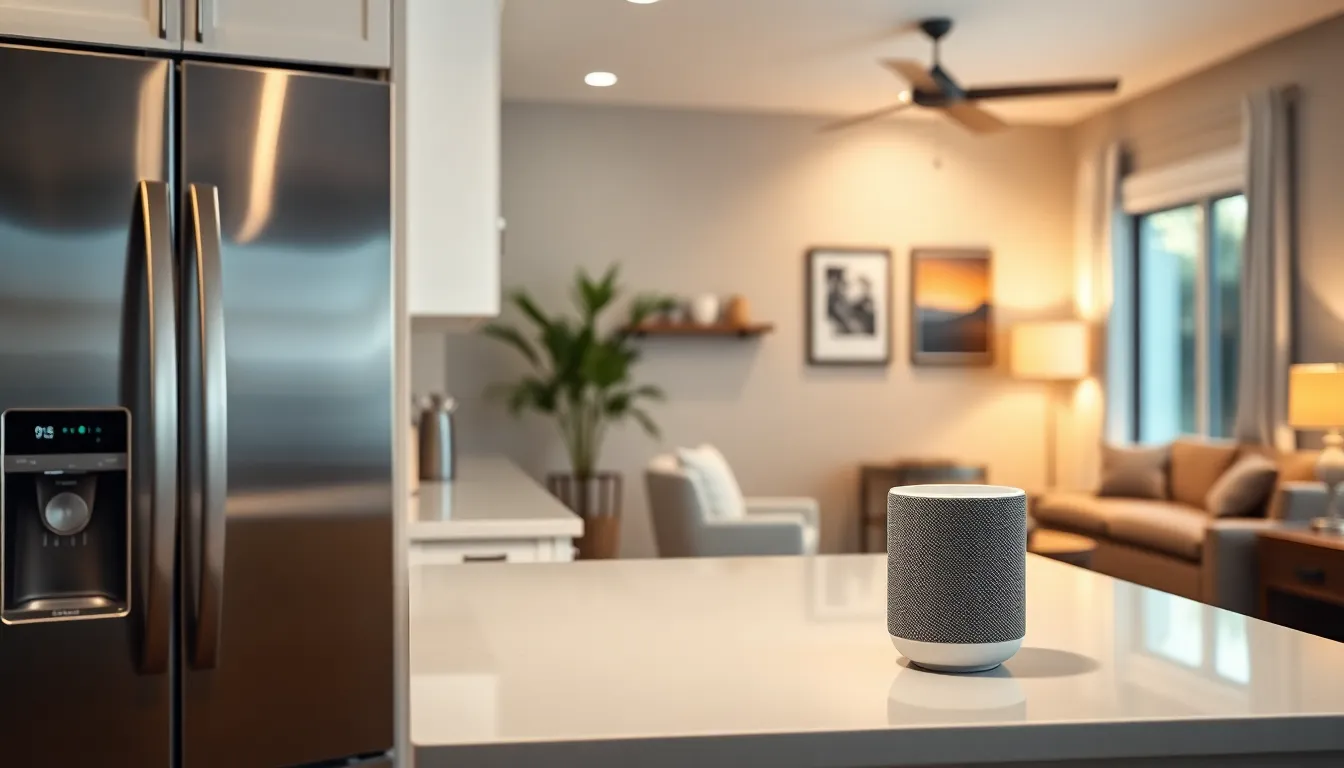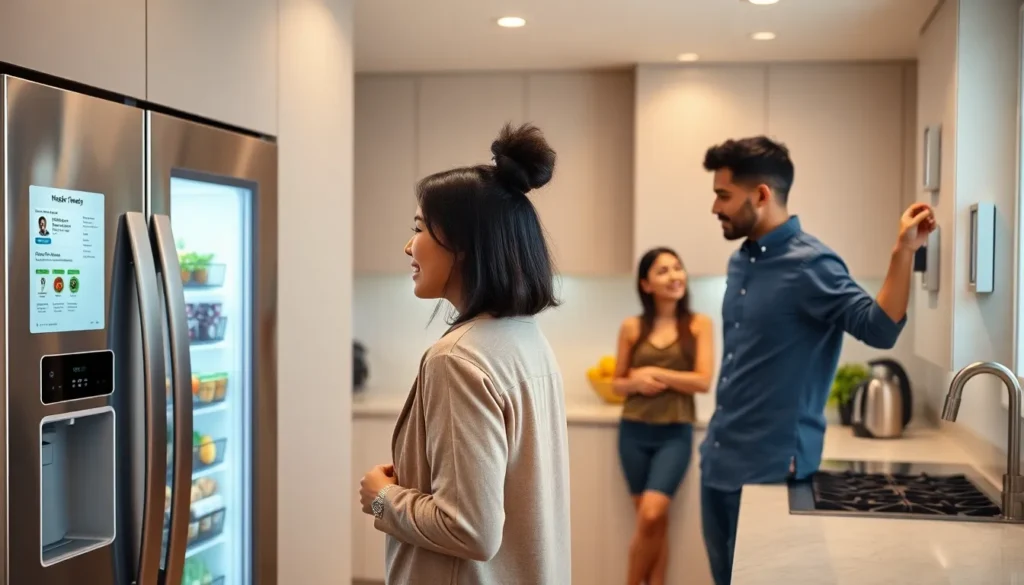Table of Contents
ToggleIn a world where your toaster might soon be smarter than you, emerging smart device technologies are reshaping everyday life in ways that feel straight out of a sci-fi movie. From refrigerators that remind you to buy more milk to smart mirrors that critique your outfit choices, these innovations are not just cool—they’re revolutionizing how people interact with their homes and themselves.
Overview of Emerging Smart Device Technologies
Emerging smart device technologies significantly enhance everyday life. Intelligent refrigerators now monitor food freshness and suggest recipes based on available ingredients. Smart mirrors provide real-time feedback, displaying weather updates, news, and calendar reminders during morning routines.
Home automation systems integrate various devices, allowing individuals to control lighting, security, and climate remotely. Wearable health devices track fitness metrics, offering insights that can improve personal wellness. Smart speakers facilitate voice commands, managing tasks and playing music through simple spoken instructions.
Artificial intelligence plays a crucial role in these innovations. AI algorithms analyze user preferences to create personalized experiences. This adaptability results in smarter, more efficient devices that learn from user interactions.
Augmented reality applications bring an immersive experience to shopping and education. For instance, customers can visualize furniture in their homes before purchasing. In educational settings, AR tools enhance learning by providing interactive and engaging content.
Security technologies also evolve, with smart locks and surveillance systems ensuring safety. These systems alert users to potential threats and can be controlled remotely.
Green technologies become integral in smart devices. Energy-efficient appliances reduce consumption while maintaining performance, which supports sustainability efforts. Solar-powered gadgets further enhance energy conservation.
Collectively, these technologies represent a paradigm shift in personal and home interactions. Daily routines benefit from streamlined processes, making life more convenient and connected. The integration of smart devices not only reflects advancement but also a commitment to improving quality of life.
Key Innovations in Smart Devices

Innovations in smart devices continue to shape the way individuals interact with technology in their daily lives. Significant advancements focus on artificial intelligence and the Internet of Things.
Artificial Intelligence Integration
Artificial intelligence enhances smart devices by personalizing user experiences. Smart speakers use AI to understand and respond to voice commands effectively. Intelligent refrigerators analyze food usage patterns and suggest recipes tailored to preferences. Smart mirrors leverage AI for displaying relevant information like weather and news during morning routines. Continuous learning algorithms allow devices to adapt over time, becoming more intuitive to individual needs. AI’s integration results in systems that streamline tasks, contributing to more efficient household management.
Internet of Things (IoT) Advancements
The Internet of Things connects various smart devices, facilitating seamless communication between them. Appliances embedded with IoT technology can be controlled remotely through apps, allowing for real-time adjustments. Smart home systems integrate lighting, security, and climate controls into a unified platform, enhancing user convenience. Wearable health devices transmit vital metrics to smartphones, enabling users to monitor wellness effectively. IoT advancements help in creating a cohesive ecosystem that enhances interaction and simplifies everyday routines. Integration fosters efficiency and enhances daily life quality.
Impact on Daily Life
Emerging smart device technologies significantly reshape daily routines. Innovations in home automation and wearable technology exemplify this transformation.
Home Automation
Home automation simplifies household management with systems that control lighting, security, and climate remotely. Smart devices work together to create an interconnected environment. Users manage settings via smartphones or voice commands, enhancing convenience in daily tasks. Intelligent refrigerators monitor food supplies, while smart thermostats adjust climate settings based on habits. Security devices like smart locks provide peace of mind by allowing remote access control. Energy-efficient appliances contribute to sustainable living, reducing both energy consumption and utility costs. The integration of these systems fosters a seamless living experience, making households more efficient.
Wearable Technology
Wearable technology plays a crucial role in personal wellness and health monitoring. Devices like fitness trackers and smartwatches collect data on physical activity, sleep patterns, and heart rate. Continuous tracking helps individuals set and achieve health goals. These gadgets sync with smartphones, providing real-time insights into personal health metrics. Notifications about exercise reminders or health alerts keep users engaged in their wellness journey. Moreover, advancements in wearable tech enhance communication, allowing users to receive calls and messages directly on their devices. This integration promotes an active lifestyle by encouraging individuals to stay connected and informed throughout the day.
Challenges and Concerns
Emerging smart device technologies showcase immense potential but also present various challenges and concerns that users must recognize.
Privacy and Security Issues
Concerns about privacy frequently arise with smart devices that collect and store user data. Data can be vulnerable to hacking, leading to unauthorized access and potential misuse. When users connect devices to the Internet of Things (IoT), they risk compromising personal information. Manufacturers face pressure to enhance security measures and protect sensitive data from breaches. Regulation of data usage and privacy is paramount, given the expanding network of interconnected devices. With heightened awareness, users should prioritize selecting devices from reputable brands committed to data protection.
Interoperability Among Devices
Interoperability remains a significant challenge for smart devices. Many models utilize different protocols and standards, creating compatibility issues between products. Inconsistent communication can hinder the seamless operation of home automation systems. Users may find it difficult to integrate devices from different manufacturers, impacting overall functionality. The development of universal standards is essential for fostering collaboration between companies. Without improved interoperability, the promise of fully integrated smart homes may remain unfulfilled, limiting user convenience and satisfaction.
Future Trends in Smart Device Technologies
Innovations in smart device technologies continue to evolve rapidly. Intelligent appliances will integrate advanced AI capabilities, allowing for seamless user interactions. Enhanced connectivity within the Internet of Things (IoT) ensures devices communicate effortlessly, improving operational efficiency throughout homes.
Sustainability becomes a significant focus as energy-efficient products gain popularity. Solar-powered gadgets reduce reliance on traditional energy sources, contributing to eco-friendly lifestyles. Green technologies help users monitor energy consumption patterns, empowering informed decisions about usage.
Health monitoring also advances with emerging wearable technologies. Devices track vital health metrics and provide real-time feedback, promoting proactive wellness management. Integration between wearables and home automation systems fosters a holistic approach to health, ensuring users maintain vital statistics.
In security, advancements in biometric authentication offer improved safety mechanisms. Smart locks and surveillance systems utilize facial recognition and fingerprint scanning to enhance home security. Such developments help alleviate concerns regarding unauthorized access and maintain user privacy.
Interoperability standards gradually improve among various smart devices. Efforts to establish universal protocols enable seamless integration, enhancing user experience within home automation systems. Manufacturers collaborate to tackle compatibility challenges, transforming smart homes into cohesive ecosystems.
Adaptive learning algorithms emerge prominently in new devices. These systems analyze user behaviors and preferences to tailor functionalities based on individual needs. Personalized interactions increase satisfaction, ensuring users engage with their devices effectively.
As emerging technologies reshape everyday life, the focus on user-centered design becomes paramount. Innovations prioritize ease of use, ensuring that smart devices remain accessible for all individuals. A growing emphasis on intuitive interfaces leads to enhanced engagement and interaction.
Emerging smart device technologies are reshaping how individuals interact with their environments. By integrating advanced features and artificial intelligence, these devices enhance convenience and promote a more efficient lifestyle. The impact on personal wellness and home management is profound, encouraging healthier habits while simplifying daily tasks.
As these innovations continue to evolve, addressing privacy and interoperability challenges will be essential. The focus on sustainability and user-centered design ensures that future developments remain accessible and beneficial for everyone. With ongoing advancements, the promise of a fully integrated smart home becomes increasingly attainable, paving the way for a more connected and efficient future.







